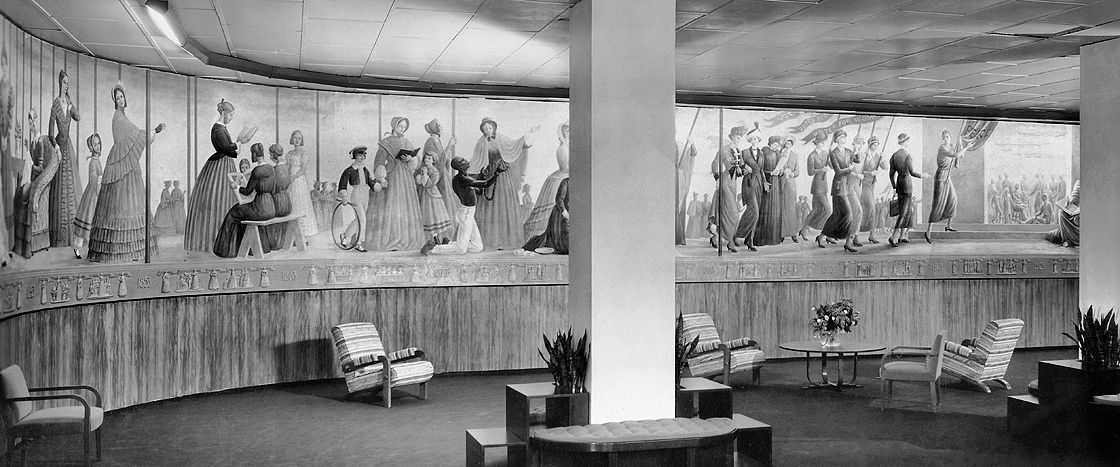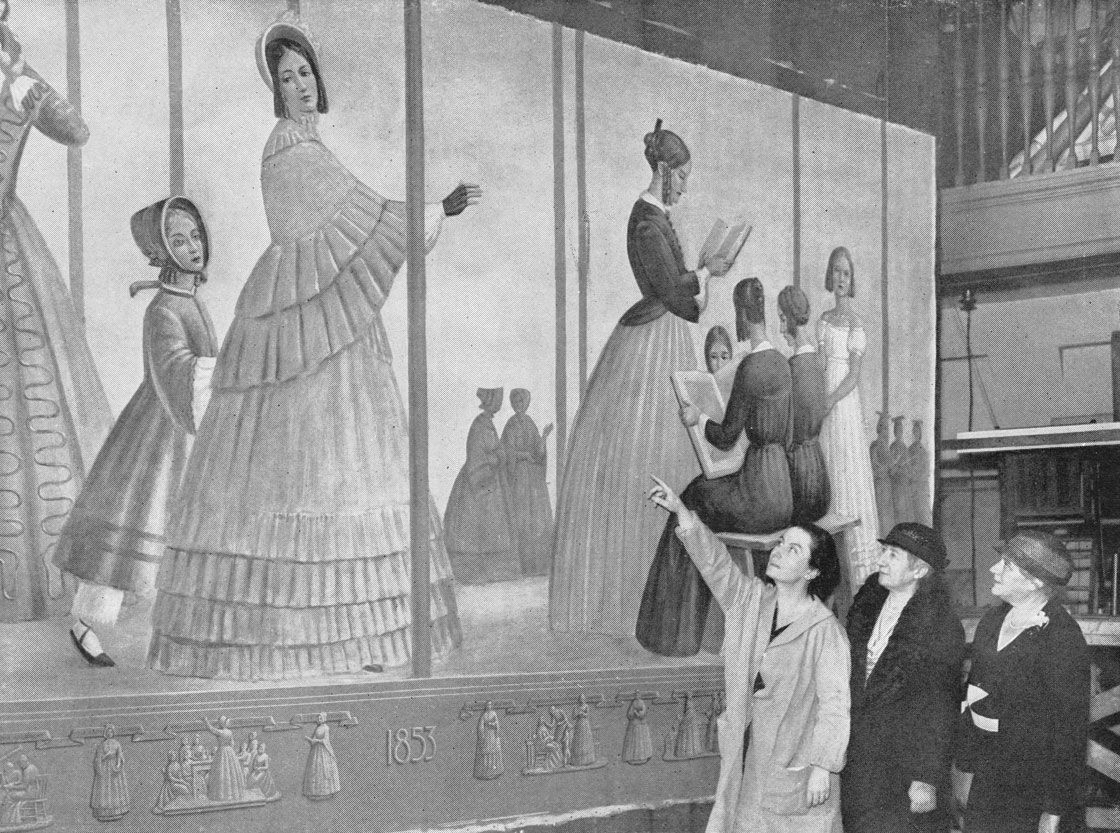Hildreth Meière Documentary Series - Watch Trailer
Hildreth Meière Documentary Series - Watch Trailer
Commissioned by: National Council of WomenMedium: oil on canvasExecuted by: Hildreth Meiere and Lynn FausettRelocated to: Smith College Museum of Art, Northampton, MA

Progress of Women, 1833-1933 in Hall of Social Sciences
Hildreth Meière received a last-minute commission from the National Council of Women to paint a mural depicting the Progress of Women, 1833-1933 as part of their exhibit in the Hall of Social Sciences.1 The commission led Meière to write to her mentor Hartley Burr Alexander:
I have just received a hurry job for the Chicago Fair. A painting sixty feet long and seven or eight feet high, for the National Council of Women, showing the progress of women during the last century through organization. I wish to heaven that you were here to work on the sketches with me. They have no conception of the artist’s problem, and I think it will be very difficult to please the ladies themselves and arrive at anything that I could possibly do in the time.2
As Meière had only two months to do the “research, make sketches, and all,” she relied heavily upon her assistant, Lynn Fausett to help with the painting, and they both signed the finished mural.3
Meière divided the century into three sections, for which she made to-scale studies in watercolor. A souvenir book published by the National Council of Women, Women Through the Century, described the episodes depicted in each section:
The woman of 1833 confined to the home and centered solely in her family
She steps over the threshold into a field of wider interest
Her education begins; schools open to her

Section One of Progress of Women, 1833-1933, study in gouache on paperboard
Women work for temperance [upholding good morals]
They succor the enslaved negroes
They aid the wounded on the Civil War battlefield
Susan B. Anthony leads out for suffrage
Women’s clubs become popular.

Section Two of Progress of Women, 1833-1933, study in gouache on paperboard
A host joins in the triumphal suffrage march
Women become prominent in business and the professions
They seek peace
They look towards the good world [of] tomorrow, for which they strive, where
men and women will share responsibilities alike, with security and opportunity for all.
At the close, Clio, the Muse of History, a book upon her knee, writes of
A Century’s Achievement for Women. A stone tablet behind her records her words:
WOMEN MARCH THROUGH
EDUCATION, SUFFRAGE
ECONOMIC FREEDOM
TOWARDS GREATER
SOCIAL JUSTICE4

Section Three of Progress of Women, 1833-1933, study in gouache on paperboard

Third section of the Progress of Women, 1833-1933. Smith College Museum of Art, Northampton, Massachusetts. Gift of the National Council of Women to the college
At the base of the mural, Meière painted a frieze in light brown to simulate wood carving. She divided the frieze into ten chronological sections, each representing a decade. For each section, Meière depicted three women pioneers and two vignettes representing important episodes in women’s achievements.

Section one of Progress of Women, 1833-1933, with frieze below
Women Through the Century described the first three sections of the frieze as follows:
1833-43: Angelina Grimke, first woman to address a public meeting; women admitted to Oberlin College, first institution of higher learning to accept them; Ann Wilkins, first missionary; the loom of the cotton mill—women enter industry; Sarah Josepha Hale, editor of Godey’s Lady’s Book—originator of our national observance of Thanksgiving.
1843-53: Lucretia Mott, anti-slavery agitator; Maria Mitchell discovers a comet; Elizabeth Cady Stanton, pioneer suffragist; the first Woman’s Rights meeting—Seneca Falls, 1848; Lucy Stone, early suffragist.
1853-63 Antoinette B. Blackwell, first woman ordained a minister; first free dispensary—New York Dispensary for poor women and children; Dr. Elizabeth Blackwell, first woman in the United States to receive an M.D. degree; first women’s hospital—Philadelphia; Dr. Emily Blackwell, co-founder with her sister of the New York Dispensary and a woman’s medical college.5
Meière wrote to Alexander: “I really like the little relief panel at the base the best of all.”3

Meière showing mural to representatives of the National Council of Women
With Meière’s approval following the 1933 Century of Progress International Exposition in Chicago, the National Council of Women gave the three-part mural and frieze below to Smith College in Northampton, Massachusetts. Today only the third section remains. It is in the collection of the Smith College Museum of Art.
For a full discussion, see Catherine Coleman Brawer, Walls Speak: The Narrative Art of Hildreth Meière (St. Bonaventure, New York: St. Bonaventure University, 2009): 70-73.
Hildreth Meière, letter to Hartley Burr Alexander, March 24, 1933, Hartley Burr Alexander Papers, Ella Strong Denison Library, Scripps College, Claremont, California.
Meière, letter to Alexander, June 19, 1935, HBA Papers.
Women Through the Century (New York: National Council of Women of the United States, 1933): n p.
The remaining decades are included in Women Through the Century, n p.
Meière, letter to Alexander, June 19, 1935, HBA Papers.